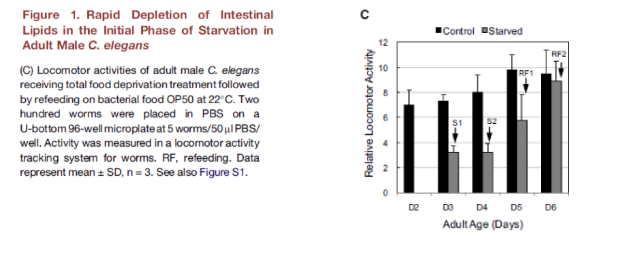
Animals have evolved a variety of mechanisms to survive in adverse living conditions, such as food shortage and drought. Upon prolonged food depletion, animals often launch a program of life alteration and enter a reversible state of dormancy (hibernation or diapause), either at their developmental or reproductive stage, to endure the stress period. On entering dormancy, animals have reprogrammed their metabolic activity, endocrine system, and other physiologies to minimize energy expenditure and protect their reproductive capacity to extend their lifespan. A wealth of insight into these processes has been gained from studies with the soil nematode Caenorhabditis elegans.
Materials and Methods:
Lipids, in most animals, are an efficient form of energy storage. They are the main energy source and are readily depleted to support animals through periods of starvation. In C. elegans, it has also been found that the slow release of energy during the dauer phase is critical for appropriate long-term osmoregulation to ensure survival; when the triglyceride resources are depleted, the osmoregulation is disrupted. Animals without a life alteration or that are no longer capable of entering a dormant state to escape from prolonged food depletion may have to modify their metabolic pathways in order to survive. These modifications are similar to those in the dormant state and may include a decrease in the metabolic rate or locomotor activity to preserve energy.
Results:
To study how animals manage their lipid stores in response to food deprivation and how such stress affects the recovery of body lipids, we used adult male C. elegans for experiments. These animals are fully developed and free of reproductive burden, so their physiology will not be complicated by dauer formation and egg production. D2 adult male worms were distributed into a U-bottom 96-well microplate at 5 males/50 ml PBS/well and subjected to starvation treatment as indicated. At the indicated time points, worm locomotor activity was monitored at 22C for 10 min every hour, for 3 consecutive hours, using a locomotor activity tracking system for worms (Wmicrotracker, DesignPlus SRL). The mean activity value from three independent measurements was used to indicate the locomotor activity (Figure 1 C).
To examine if the rapid loss of lipid stores during early starvation is caused by hyperactivity, we determined the locomotor activity of the starved male worms by using the WMicrotracker system.
We found that the starved worms had actually reduced their physical activity, indicating that the rapid lipid loss is not due to an increase in physical activity.

…………………………………………………………………………………………………………………………..
Cell Metab. 2011 Sep 7;14(3):390-402. doi: 10.1016/j.cmet.2011.06.019.
Kien Thiam Tan, Sheng-Ching Luo, Wan-Zo Ho, and Ying-Hue Lee
